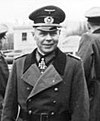19th Army (Wehrmacht)
| 19th Army | |
|---|---|
| German: 19. Armee | |
 1944, anti-tank fortifications in Southern France | |
| Active | 26 August 1943 – 21 April 1945 |
| Country | |
| Branch | |
| Type | Field army |
| Engagements | |
The 19th Army (German: 19. Armee) was a World War II field army of the German Army. Active from 1943 to 1945 on the Western Front, it was tasked with defending southern France and before being pushed back to the French–German border during Operation Dragoon and then into southern Germany.
History
[edit]Formed in August 1943 in occupied southern France from Armeegruppe Felber (the LXXXIII. Armeekorps), the 19th Army defended southern France, the Vosges Mountains, Alsace, Baden and southern Württemberg during the Allied invasion of southern France and other large Allied military operations that had as their goal the liberation of southern France and the invasion of southern Germany.
Although nominally a field army, the 19th Army was under strength and consisted of third tier soldiers, wounded veterans, conscripts and Hiwis. Southern France in general was treated as a third tier theatre and given minimal attention by the OKW. The entire army was outfitted with damaged and obsolete equipment, with four of the 19th army's divisions designated "static divisions," meaning that they were stripped of all mobile assets and forbidden to move from their assigned positions. The Hiwis in particular proved unreliable and typically deserted or surrendered at the first opportunity. One of those units subordinated to the 19th Army was the 30th Waffen Grenadier Division of the SS, before it was withdrawn to Germany in December 1944 after sustaining heavy losses.
At the time of the Allied landings in Normandy on 6 June 1944, the 19th Army was headquartered at Avignon and subordinate to Army Group G at Toulouse.[1]: 442
During Operation Dragoon, the 19th Army was trapped in an enormous encirclement, suffering 7,000 killed or missing, 20,000 wounded, 130,000-140,000 captured and was largely destroyed as a fighting force. However, its headquarters survived intact, retreated northwards and participated in the defense of the Rhine River.
| Organization: 19th Army on July 17, 1944 | |||
|---|---|---|---|
| Army Group | Army | Corps | Division |
| G Blaskowitz |
19th Army Wiese |
LXII Corps Neuling |
148th Infantry Division |
| 242nd Infantry Division | |||
| LXXXV Corps Knieß |
244th Infantry Division | ||
| 338th Infantry Division | |||
| IV Luftwaffe Corps Petersen |
189th Infantry Division | ||
| 198th Infantry Division | |||
| 716th Infantry Division | |||
| Subordinated to Army HQ |
157th Reserve (Mountain) Division | ||
After the debacle in Southern France, the 19th Army was recreated with poorly trained conscripts and tasked with defending the west bank of the Rhine, and the city of Strasbourg. The 19th Army was again encircled and largely destroyed during the battle for the Colmar Pocket in January and February 1945. Once again its headquarters survived capture and was rebuilt largely from Volkssturm and hastily trained replacement troops in early 1945. With many of its best men and junior leaders dead or captured, the 19th Army's effectiveness was seriously impaired and it proved unable to parry the thrusts of its constant foe, the French First Army. Split by deep French armored thrusts into Baden, the Black Forest, and Württemberg, the 19th Army was destroyed in the area of Stuttgart and Münsingen in late April 1945, with remnants of the army surrendering as late as 8 May 1945. Formal surrender was accepted by Maj. General Edward H. Brooks, Commander of the U.S. Army's VI Corps.
April 19, 1945
| Organization: 19th Army on April 12, 1945 | |||
|---|---|---|---|
| Army Group | Army | Corps | Division |
| G Schulz |
19th Army Brandenberger |
XVIII SS Corps Keppler |
Baur Infantry Brigade |
| 1005th Infantry Brigade | |||
| 805th Infantry Division | |||
| 405th Infantry Division | |||
| LXIV Corps Grimmeiß |
106th Infantry Division | ||
| 257th Volksgrenadier Division | |||
| 716th Infantry Division | |||
| LXXX Corps Beyer |
16th Volksgrenadier Division | ||
| 47th Volksgrenadier Division | |||
| 198th Infantry Division | |||
| 559th Volksgrenadier Division | |||
| Subordinated to Army HQ |
189th Infantry Division | ||
Commanders
[edit]| No. | Portrait | Commander | Took office | Left office | Time in office |
|---|---|---|---|---|---|
| 1 | General der Infanterie Georg von Sodenstern (1889–1955) | 26 August 1943 | 29 June 1944 | 308 days | |
| 2 | General der Infanterie Friedrich Wiese (1892–1975) | 29 June 1944 | 15 December 1944 | 169 days | |
| 3 | General der Infanterie Siegfried Rasp (1898–1968) | 15 December 1944 | 15 February 1945 | 62 days | |
| 4 | General der Infanterie Hermann Foertsch (1895–1961) | 15 February 1945 | 28 February 1945 | 13 days | |
| 5 | General der Infanterie Hans von Obstfelder (1886–1976) | 1 March 1945 | 26 March 1945 | 25 days | |
| 6 | General der Panzertruppe Erich Brandenberger (1892–1955) | 26 March 1945 | 6 May 1945 | 41 days |
See also
[edit]- 19th Army (German Empire) for the equivalent formation in World War I
References
[edit]- ^ Pöhlmann, Markus (2016). Der Panzer und die Mechanisierung des Krieges: Eine deutsche Geschichte, 1890 bis 1945 (in German). Ferdinand Schöningh. ISBN 9783506783554.
Further reading
[edit]- Tessin, Georg, (1976). Verbände und Truppen der deutschen Wehrmacht und Waffen-SS im Zweiten Weltkrieg 1939-1945 (Volume IV), Biblio Verlag, Osnabrück. ISBN 3-7648-1083-1.





